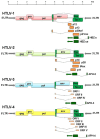Human T-Lymphotropic Virus (HTLV): Epidemiology, Genetic, Pathogenesis, and Future Challenges
- PMID: 40431676
- PMCID: PMC12115942
- DOI: 10.3390/v17050664
Human T-Lymphotropic Virus (HTLV): Epidemiology, Genetic, Pathogenesis, and Future Challenges
Abstract
Human T-lymphotropic viruses (HTLVs) are deltaretroviruses infecting millions of individuals worldwide, with HTLV-1 and HTLV-2 being the most widespread and clinically relevant types. HTLV-1 is associated with severe diseases such as adult T-cell leukemia/lymphoma (ATL) and HTLV-1-associated myelopathy/tropical spastic paraparesis (HAM/TSP), while HTLV-2 shows a lower pathogenic potential, with occasional links to neurological disorders. HTLV-3 and HTLV-4, identified in Central Africa, remain poorly characterized but are genetically close to their simian counterparts, indicating recent zoonotic transmission events. HTLVs replicate through a complex cycle involving cell-to-cell transmission and clonal expansion of infected lymphocytes. Viral persistence is mediated by regulatory and accessory proteins, notably Tax and HBZ in HTLV-1, which alter host cell signaling, immune responses, and genomic stability. Integration of proviral DNA into transcriptionally active regions of the host genome may contribute to oncogenesis and long-term viral latency. Differences in viral protein function and intracellular localization contribute to the distinct pathogenesis observed between HTLV-1 and HTLV-2. Geographically, HTLV-1 shows endemic clusters in southwestern Japan, sub-Saharan Africa, the Caribbean, South America, and parts of the Middle East and Oceania. HTLV-2 is concentrated among Indigenous populations in the Americas and people who inject drugs in Europe and North America. Transmission occurs primarily via breastfeeding, sexual contact, contaminated blood products, and, in some regions, zoonotic spillover. Diagnostic approaches include serological screening (ELISA, Western blot, LIA) and molecular assays (PCR, qPCR), with novel biosensor and AI-based methods under development. Despite advances in understanding viral biology, therapeutic options remain limited, and preventive strategies focus on transmission control. The long latency period, lack of effective treatments, and global neglect complicate public health responses, underscoring the need for increased awareness, research investment, and targeted interventions.
Keywords: HAM/TSP; HTLV; adult T-cell leukemia/lymphoma; deltaretrovirus; epidemiology; genetic characterization; genomics; molecular diagnostics.
Conflict of interest statement
The authors declare no conflicts of interest.
Figures



References
-
- Poiesz B.J., Ruscetti F.W., Gazdar A.F., Bunn P.A., Minna J.D., Gallo R.C. Detection and isolation of type C retrovirus particles from fresh and cultured lymphocytes of a patient with cutaneous T-cell lymphoma. Proc. Natl. Acad. Sci. USA. 1980;77:7415–7419. doi: 10.1073/pnas.77.12.7415. - DOI - PMC - PubMed
-
- Legrand N., McGregor S., Bull R., Bajis S., Valencia B.M., Ronnachit A., Einsiedel L., Gessain A., Kaldor J., Martinello M. Clinical and public health implications of human T-lymphotropic virus type 1 infection. Clin. Microbiol. Rev. 2022;35:e00078-21. doi: 10.1128/cmr.00078-21. - DOI - PMC - PubMed
Publication types
MeSH terms
LinkOut - more resources
Full Text Sources
Miscellaneous

